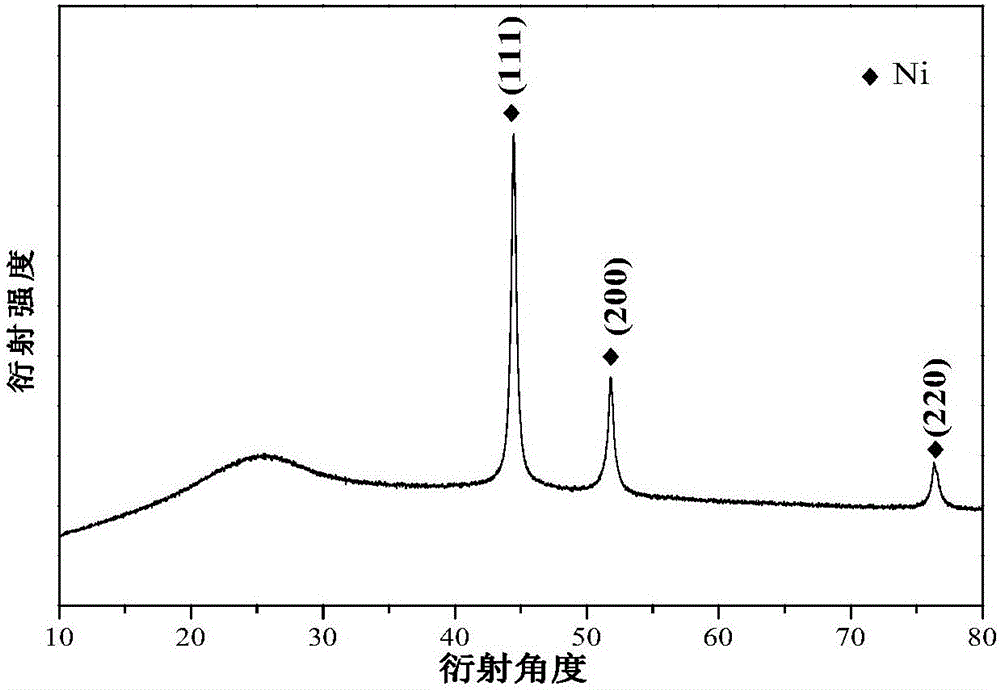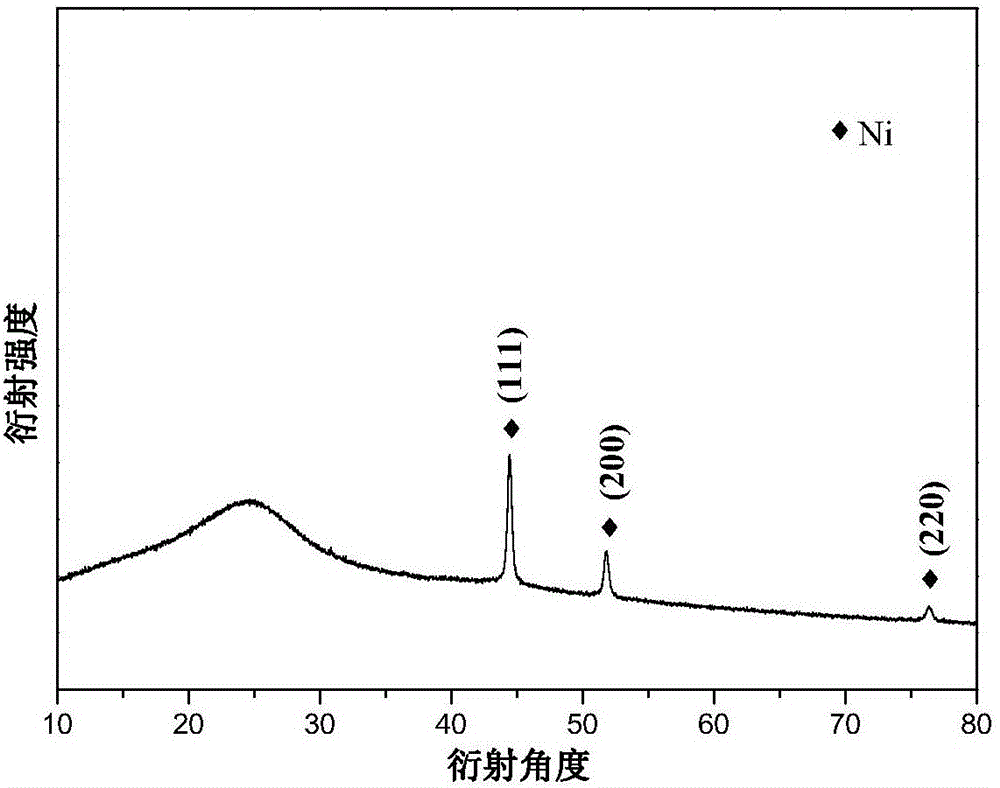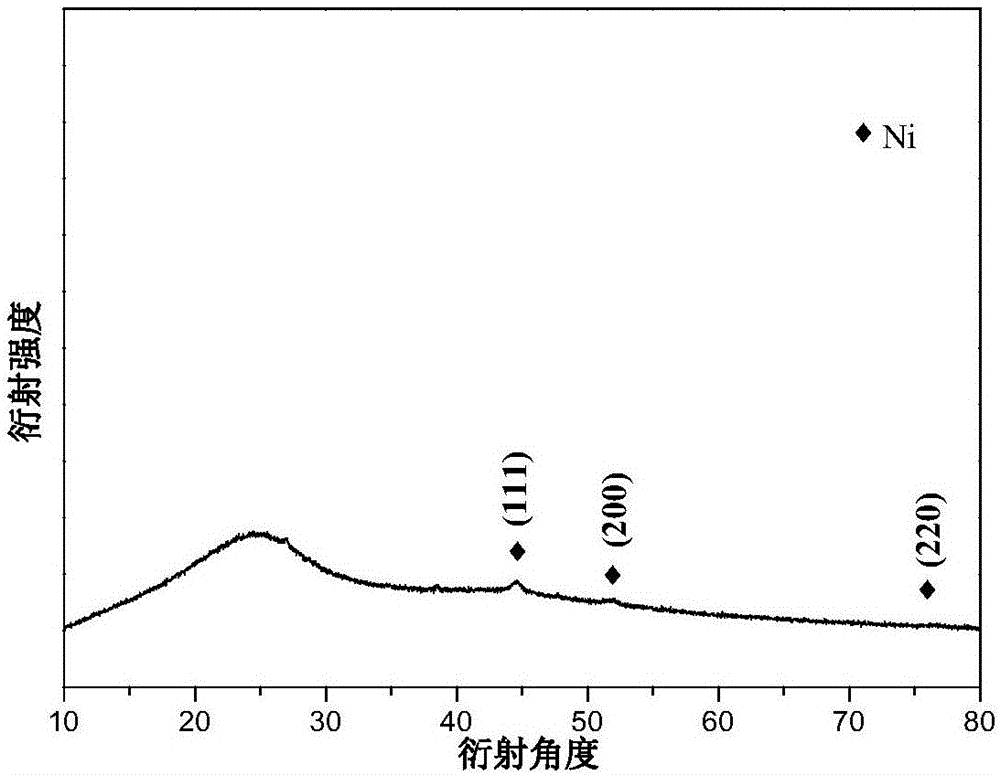Method for preparing porous carbon loaded nano-metal through microwave assistance
A nano-metal and microwave-assisted technology is applied in the field of porous carbon-supported nano-metal oxides or nano-metal materials, and achieves great application prospects, low cost, and high monodispersity.
- Summary
- Abstract
- Description
- Claims
- Application Information
AI Technical Summary
Problems solved by technology
Method used
Image
Examples
Embodiment 1
[0028] Example 1: Porous carbon loaded nano-Ni
[0029] Synthetic raw materials: glucose, urea, Ni(NO 3 ) 2` 6H 2 O (nickel nitrate)
[0030] (1) Weigh 1.5 g glucose, 2.5 g urea and 0.9 g Ni(NO 3 ) 2 9H 2 O in a 100 mL beaker, then place the beaker in a heatable magnetic stirrer. The temperature of the magnetic stirrer was raised to 120° C., and the stirring was continued for 10 min until the medicine in the beaker was in a molten state.
[0031] (2) Take out the molten liquid described in (1), put it into a microwave and heat it with a heating power of 300w, and heat it for 15 minutes to obtain a dark brown puffy solid.
[0032] (3) Grind the sample obtained in (2) with a mortar, and put it in a crucible, at 500 ° C, 5% H 2 / N 2 After heat treatment for 5 h under the same conditions, nano-Ni supported on porous carbon was obtained. XRD test showed that the particle size of Ni was 35 nm.
[0033] figure 1 It is the XRD pattern of nano-metal Ni supported on porous ca...
Embodiment 2
[0034] Example 2: Porous carbon loaded nano-Ni
[0035] Synthetic raw materials: glucose, urea, Ni(NO 3 ) 2` 6H 2 O (nickel nitrate)
[0036] (1) Weigh 1.5 g glucose, 2.5 g urea and 0.9 g Ni(NO 3 ) 2 9H 2 O in a 100 mL beaker, then place the beaker in a heatable magnetic stirrer. The temperature of the magnetic stirrer was raised to 120° C., and the stirring was continued for 10 min until the medicine in the beaker was in a molten state.
[0037] (2) Take out the molten liquid described in (1), put it into a microwave and heat it with a heating power of 500w, and heat it for 10 minutes to obtain a dark brown puffy solid.
[0038] (3) Grind the sample obtained in (2) with a mortar, and put it in a crucible, at 500 ° C, 5% H 2 / N 2 After heat treatment for 5 h under the same conditions, nano-Ni supported on porous carbon was obtained. XRD test showed that the particle size of Ni was 22 nm.
[0039] figure 2 It is the XRD pattern of nano-metal Ni supported on porous c...
Embodiment 3
[0040] Example 3: Porous carbon loaded nano-Ni
[0041] Synthetic raw materials: glucose, urea, Ni(NO 3 ) 2` 6H 2 O (nickel nitrate)
[0042] (1) Weigh 1.5 g glucose, 2.5 g urea and 0.9 g Ni(NO 3 ) 2 9H 2 O in a 100 mL beaker, then place the beaker in a heatable magnetic stirrer. The temperature of the magnetic stirrer was raised to 120° C., and the stirring was continued for 10 min until the medicine in the beaker was in a molten state.
[0043] (2) Take out the molten liquid described in (1), put it into a microwave and heat it with a heating power of 700w, and heat it for 5 minutes to obtain a dark brown puffy solid.
[0044] (3) Grind the sample obtained in (2) with a mortar, and put it in a crucible, at 500 ° C, 5% H 2 / N 2 After heat treatment for 5 h under the same conditions, nano-Ni supported on porous carbon was obtained. XRD test showed that the particle size of Ni was 8 nm.
[0045] image 3 It is the XRD pattern of nano-metal Ni supported on porous carb...
PUM
| Property | Measurement | Unit |
|---|---|---|
| Particle size | aaaaa | aaaaa |
| Particle size | aaaaa | aaaaa |
| Particle size | aaaaa | aaaaa |
Abstract
Description
Claims
Application Information
 Login to View More
Login to View More - R&D
- Intellectual Property
- Life Sciences
- Materials
- Tech Scout
- Unparalleled Data Quality
- Higher Quality Content
- 60% Fewer Hallucinations
Browse by: Latest US Patents, China's latest patents, Technical Efficacy Thesaurus, Application Domain, Technology Topic, Popular Technical Reports.
© 2025 PatSnap. All rights reserved.Legal|Privacy policy|Modern Slavery Act Transparency Statement|Sitemap|About US| Contact US: help@patsnap.com



